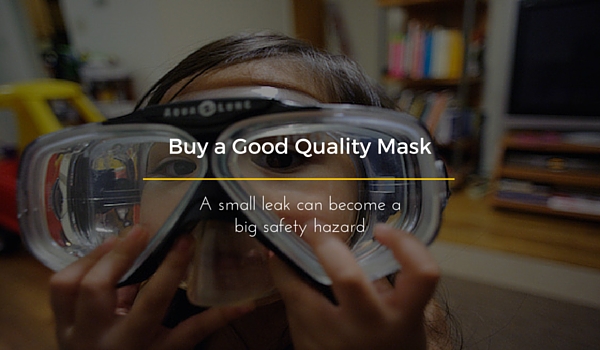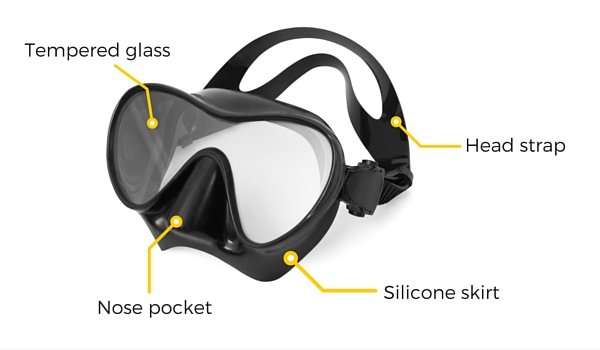6 Helpful Tips To Help you Prevent Your Scuba Mask from Leaking
In this article we explain how to prevent your scuba mask from leaking. This common problem, however, can be prevented if you follow a few simple steps to ensure your mask will fit your face perfectly and keep all moisture outside of it, where it belongs.

Photo Credit: @kevinv033
The diving mask is one of the first items that most divers purchase when they learn to dive. Often they will do so with little or no knowledge of that they are doing. The sales staff might be helpful, but that is no guarantee that they know what they are doing either.
While a small leak might be annoying to a diver, it could cause a situation where it is also a safety hazard.
The diver is so focused on keeping the mask clear that they are not enjoying the dive or worst, and they fail to notice a dangerous situation such as drifting too deep or low on air.
Read on to find 6 valuable tips to help prevent your scuba mask from leaking.
Spend some extra bucks on a good quality mask.
Mask are one of the least expensive items of your diving kit. A few extra dollars will give you a better quality and well worth the slightly higher price tag.
A diving mask is more expensive than a snorkeling mask, generally because of the better materials. It not always the case, there are a few companies that sell the same product under different names and at different prices.
Your dive mask will have a few items that are necessary, but that might not apply to a snorkeling mask. First the face plate should be tempered glass. If it is, it will be clearly marked on the glass itself.
The skirt of the mask is where most of the quality and cost differences come into play. The skirt is the flexible portion that connects to the face plate and fits your face. Silicon is used almost exclusively in diving skirts.

The better the quality of the silicon the greater the flexibility, which allows it to mold to your skin better. Clear silicon is often used. The clearer it is, the higher the quality.
The best quality is medical grade, followed by food grade. Below food grade is not acceptable for diving, however, might be acceptable for snorkeling.
You will find diving masked with colored skirts. However, they are not as common and used for special purposes. When you look at the skirt, you need to look at the edge.
Where the face comes into contact with your face, there should be a double edge. On the inside of the mask close to the edge should be a little “ridge” of silicon that helps provides a double seal. The skirt must also have a nose pocket. It needs to fully over the nose but be flexible enough that you can squeeze your nose closed through the skirt. This is necessary to equalize as you descend.
The mask will also have a strap, often of the same silicon as the skirt. Some divers will replace these with ones made of neoprene, as many divers find them more comfortable. Especially female divers with long hair. The key point is that it is comfortable. The function of the strap is mostly to hold the mask in the right position.
A tight strap doesn’t mean you’ll get a tight seal
Some divers attempt tightening the strap on the mask in an effort to get it to seal properly to their faces. But this is ineffective and will only result in damage caused to the skirt of your mask. Instead, focus on getting a high quality mask made of the best materials that is the correct size for your face in order to get the best seal and maintain that seal throughout your dive.
How to make sure your mask fits your face?
When you are purchasing a mask, there are two tests you need to do to insure the mask you purchase is a proper fit. If you do not get a proper fit, it will be impossible to keep the mask from leaking.
Put on the mask with the strap gently holding it in place. Look in the mirror and note if the mask can be centered on your face, and does not extend past your cheeks. Also, double check if the nose feels comfortable. Pressure on the nose, either on the front or bottom will tell you the shape is not right for you.
Look around and determine if you can see well enough. The second test is the one everyone is always telling you about. Remove the mask and have the strap in front of the mask. Remove the hair from around your face and place the mask in position. Inhale by the nose and the mask should press against the face. Try to sense any air leaking into the mask.
Hold your breath and determine if the mask will stay in place. If it does and you sensed no air leak the mask should do well. Men with facial growth may have difficulties getting a good seal, in those case they might need to apply a petroleum jelly to their facial hair.
Also read: 5 Stupid Things You Should Never Do While Scuba Diving
Always wear your mask properly
At the beginning of your dive place, the mask on your face making sure it is in the proper position and all of your hair is out of the way. The strap should be positioned on your head so that it is neither higher nor lower than the center of the mask.
The strap should not be tight enough to put pressure on the skirt. It is mostly for positioning. Placing the strap in the wrong position could cause the skirt to buckle and leak.
After entering the water from a boat, check the position of your mask. You may have to remove it, dunk your head to clear the hair and replace your mask. While enjoyment is a great part of diving, smiling can cause some leakage.
Store your mask like you store all your precious scuba gear.
Never leave your mask where any weight can be placed on it, that will cause pressure on the skirt and miss form it. The glass should always be up and away from surfaces that can scratch it. Most mask come with a plastic storage case, if your mask did not, get one. Whenever possible, keep the mask in the case
Also read: 5 Valuable and Easy to Follow Scuba Kit Maintenance Tips
Cleaning and maintenance
With a little gentle handling, the mask will last years if not decades. Try to get your mask out of direct sunlight as much as possible. After the end of each diving day, soak the mask in fresh water. If you can rinse the mask in fresh water between dives, do that as well.
Separately wash the plastic container in fresh water and a little baby shampoo. You want to ensure that no sand or salt remain in the container.
Inspect the mask to ensure that it is clean, pay close attention to the area under the inside seal looking for salt or sand. Check the nose pockets and where the skirt attaches to the faceplate.
When satisfied, dry the mask with a micro-cloth and placed in the container. The container should be the top item in your kit, so nothing is on top of it. A leaking scuba mask is annoying but a fogged scuba mask too.
As simple as it seems, these few steps can keep your mask from leaking and allow you to enjoy it for years.
Did you ever han any problems with a leaking scuba mask? Let us know in the comments below
This article is published by The Scuba Page, the online magazine for Scuba Dive lovers around the world. The Scuba Page is part of RUSHKULT: the online booking platform for adventure sports. Visit the RUSHKULT platform to book your next Scuba Dive training, guided trip and accommodation.

Leave a Comment